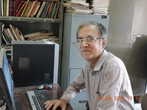This event is organized to celebrate Professor Bhaskar Bagchi's career at the Indian Statistical Institute, Bangalore Centre.
Speakers: Niranjan Balachandran (IIT Bombay, Mumbai) ,
Gadadhar Mishra (IISc, Bangalore) , Basudeb Datta (IISc, Bangalore) and Bhaskar Bagchi (ISI, Bangalore).
Slides of the talks by Prof. Basudeb Datta and
Prof. Niranjan Balachandran.
Time: 10.00 AM - 12.30 PM and 2.00 PM - 5.30 PM.
Date: January 29, 2019
Venue: Second Floor auditorium
Schedule:
|
Speaker:
Gadadhar Misra [Top]
Title: A product formula for homogeneous characteristic functions
Abstract: A bounded linear operator $T$ on a Hilbert space is said to be homogeneous if$\varphi(T)$ is unitarily equivalent to $T$ for all $\varphi$ in the group M\"{o}b of bi-holomorphic automorphisms of the unit disc. A projective unitary representation $\sigma$ of M\"{o}b is said to be associated with an operator T if $\varphi(T)= \sigma(\varphi)^\star T \sigma(\varphi)$ for all $\varphi$ in M\"{o}b.
If T is a completely non unitary (cnu) contraction with associated (projective unitary) representation $\sigma$, then there is a unique projective unitary representation$\hat{\sigma}$, extending $\sigma$, associated with the minimal unitary dilation$W$ of $T$. The representation$\hat{\sigma}$ is given in terms of $\sigma$by the formula $$ \hat{\sigma} = (\pi \otimes D_1^+) \oplus \sigma \oplus (\pi_\star \otimes D_1^-), $$ where $D_1^\pm$ are the two Discrete series representations (oneholomorphic and the other anti-holomorphic) living on the Hardy space $H^2(\mathbb T)$, and $\pi, \pi_\star$ are representations of M\"{o}b living on the two defect spaces of $T$defined explicitly in terms of $\sigma$.
Moreover, the characteristic function$\theta_T$ of a homogeneous cnu contraction$T$ with an associated representation$\sigma$ is of the form $\theta_T(z) = \pi_\star(\varphi_z)^* \theta_T(0) \pi(\varphi_z),$ $z\in \mathbb D$, where$\varphi_z$ is the involution in M\"{o}b mapping $z$ to $0.$ We obtain a concrete realization of this product formula for a large class of homogeneous cnu contractions.
This talk is based on the joint work with Bhaskar Bagchi and Somnath Hazra.
|
|
Speaker:
Niranjan Balachandran [Top]
Title: Zero sum problems in abelian groups and some related extremal problems
Abstract: Zero-sum problems in abelian groups is an area of very active
research interest in additive combinatorics and combinatorial number
theory. The object of interest is the determination of certain
combinatorial invariants of the group. In this talk, we shall look at two
different aspects of two of these invariants - the weighted Davenport
constant and the Harborth constant. Our focus on
(i) the weighted Davenport constant is geared towards a couple of very
natural extremal problems which seem to have gone, hitherto unstudied, and
(ii) the Harborth constant is to draw an extension of that notion to the
dihedral group and determine it for the dihedral group.
(i) Based on joint work with Eshita Mazumdar, and
(ii) Based on joint work with Eshita Mazumdar and Kevin Zhao.
|
|
Speaker:
Basudeb Datta [Top]
Title: Semi-regular maps on the surfaces
Abstract: A vertex-transitive map $X$ is a map on a surface on which the automorphism group of $X$ acts transitively on the set of vertices of $X$. If the face-cycles at all the vertices in a map are of same type then the map is called a semi-regular or a semi-equivelar map. Clearly, a vertex-transitive map is semi-regular. Converse of this is not true in general. The boundaries of Platonic solids and Archimedean solids are vertex-transitive maps on the 2-sphere. The boundary of the pseudo-rhombicuboctahedron is a semi-regular map on the 2-sphere and is not a vertex transitive map. All the Archimedean tilings on the plane are vertex-transitive maps. A map on the torus is semi-regular if and only if it is a quotient of an Archimedean tiling. In this talk, we discuss semi-regular maps on the 2-sphere, on the torus and on the hyperbolic plane.
|
|
Speaker:
Bhaskar Bagchi [Top]
Title: On friendly cats and dogs
Abstract: In a certain house, there are a number of cats and dogs. Any two of the cats have exactly two common friends among the dogs, and any two of the dogs have exactly two common friends among the cats. Question : what is the maximum
possible number of dogs in this house? It may sound like a silly puzzle,
but I conjecture that there can be a maximum of 79 dogs here. I shall
discuss the surprising mathematics into which I am led in trying to solve
this puzzle.
|
Registration is closed.
Organizers: Parthanil Roy (email: parthanil.roy-at-gmail-dott-com) and D. Yogeshwaran (email: d.yogesh-at-isibang-dott-ac-dott-in).
Note: No travel or accommodation support will be provided for attending the event and queries regarding the same will not be entertained.
This page was last modified on January 4, 2019.
[ Indian Statistical Institute ] [ Stat-Math Unit ]
|
